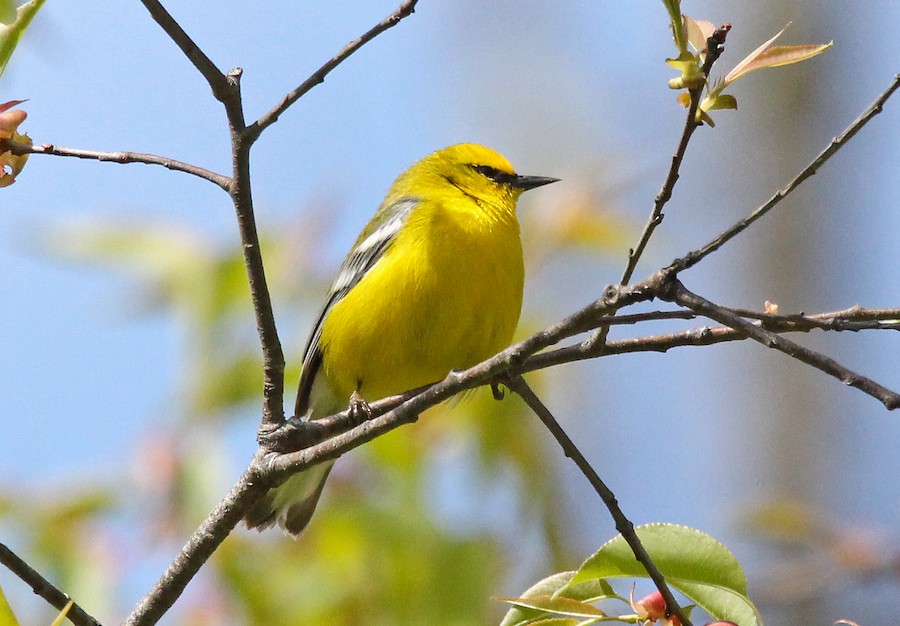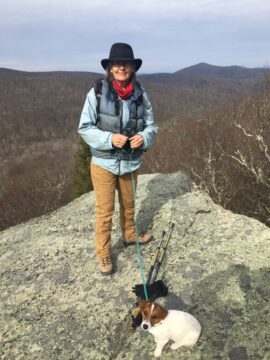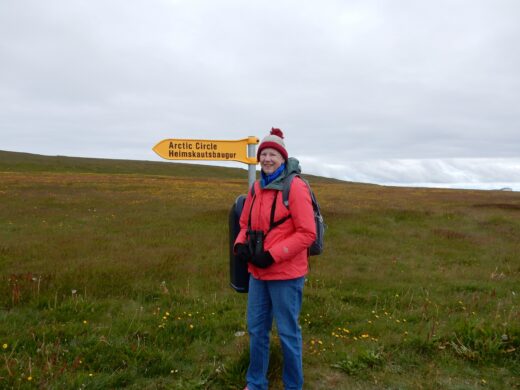By Eric Wallace

Blue-winged Warbler Vermivora cyanoptera © Anonymous eBirder
A big final-season push is bringing interesting finds and spectacular statistics from across the state. Learn more about them below.
We’re on the last leg of our journey through the final season of the second Virginia Breeding Bird Atlas—and progress reports are looking great!
“Yes, the pandemic blindsided us,” says project director Dr. Ashley Peele, an avian ecologist with the Virginia Tech Conservation Management Institute, “but volunteers responded with astounding resilience. To say they’ve kicked things up a notch would be an understatement.”
Small groups of dedicated citizen scientists and individuals have led the way. To date, they’ve logged about 90 percent of the total average field-hours for each of the prior four seasons. Defying odds, they’re on track to make 2020 the VABBA2’s most active year yet.
“To me, this project is too important to just give up on,” says former Virginia Wilderness Committee president, Laura Neale, an avid atlaser. Many avian species are declining at an alarming rate. Data from the VABBA2 is integral to implementing better and more effective avian-related conservation efforts in the future.
To grasp the degree of volunteer investiture, one need only look at current stats for completed priority blocks. (For a detailed definition and description of the term, click here.)
- About 320, or 40 percent, were finished between 2016-2019.
- So far in 2020, another 134—or 17 percent—have been completed.
- Though roughly 23 percent of all priority blocks still need work or are currently being wrapped up, 98 percent have received attention from atlasers.
- Among the unfished blocks that have not been assigned to field technicians, 39 are only missing nocturnal surveys. Just 38 have less than six survey-hours logged.
Volunteer efforts have brought other rewards too. Having spent an estimated 70,000 hours combing the state looking for breeding birds, it’s no wonder they’ve discovered a slew of interesting new trends and finds.
For instance, as of this June, the project had confirmed 197 avian species breeding in the state. Among them are a few that were unaccounted for in the first atlas, which was completed in 1989. The list includes Anhinga, Mississippi Kite and Painted Bunting.
Increased survey time in the southwestern Piedmont and Mountain-Valley region (southwest Virginia) has yielded fascinating observations. For example, detections of declining neotropical migrant species like Blue-winged, Swainson’s, and Kentucky Warbler have increased substantially. Concentrations of Blue-winged are found throughout Buchanan, Dickenson, Tazewell and Wise counties—all areas that overlay nicely with reclaimed mining lands. Comparatively abundant sightings of Kentucky Warbler in 2020 seems to suggest a great year for its breeding population in the state.
Time spent atlasing in high-elevation areas has led to more neat finds. For instance, a group of young birders spotted a rare female Purple Finch carrying materials to a probable nesting site while visiting Highland County. On that same trip, they found a nesting Hermit Thrush. Meanwhile, Laura Neale saw a quartet of Swainson’s Thrush in the high mountains of Alleghany County.
“Much to my delight, the list goes on and on,” says Peele. Though currently focused on supervising a large group of field technicians and helping volunteers coordinate strategic efforts to complete as many priority blocks as possible before the VABBA2 concludes in early August, she looks forward to sifting through what she calls her “treasure horde of data.”
“I’m excited to dig in and take a closer look at everything our amazing volunteers and field technicians have discovered,” says Peele. “This is profoundly important information. In terms of avian conservation, it’s going to be a real game changer for Virginia’s management and conservation planning moving forward.”
—
Interested in taking a peek inside the world of some of the VABBA2’s top citizen scientists? You’re in luck. We recently caught up with two of our most currently active volunteers.
Below, they shed light on why they chose to bird for the VABBA2, final season efforts, and share a few of their favorite atlasing adventures.
—

Laura Neale at Wolf Rocks March 2020
Laura Neale, Fairfield— Laura is a certified Virginia Master Naturalist that moved to Rockbridge County in 1988 after working in public gardens in North Carolina, including Manteo’s Elizabethan Gardens. She has since served as a founder and board member of the upper James River chapter of the Virginia Native Plant Society, the revived Rockbridge Bird Club, and the Virginia Wilderness Committee.
When did you start atlasing for the VABBA2 and why?
I started the first year and was a total novice at how one goes about determining whether a bird is breeding. Searching for well-hidden nests? Totally intimidating!
But I was extremely excited that Virginia was going to engage in a five-year data collection project with an ultimate goal of driving conservation policy. So, I studied the Atlas Handbook, fell in love with its block tool, acquired a smartphone, attended trainings, and went to work.
What have your efforts with the VABBA2 looked like to date?
At some point I realized that atlasing was essentially a next-level form of birding—one that’s a bit more involved and demands patience and attentive observation. But, because it requires you to totally focus on behavior, you end up learning a lot about birds.
The first couple of years, I was nervous about committing to completing a priority block by myself. I mostly focused on chipping away at those within driving distance of where I live.
By the third season, though, I’d gotten really excited about the concept of ‘block-busting.’ I started atlasing with my sister Amy and friends at the Rockbridge Bird Club, [like current treasurer] Wendy Richards and fieldtrip chair, Bob Biersack.
You’ve recently been working to complete more priority blocks. Where have you been focusing your efforts?
I think I started looking forward to this final atlas field season the moment the last one ended!
Looking ahead, I started working with Ashley Peele [in late-2019] to look for data holes—most of which were located in western, southwestern and southside Virginia. Neighboring Alleghany County had some tantalizing gaps, so I decided to focus on them. I also signed up to attend all of the 2020 Atlasing Rallies.
What are some projects you would like to see come out of the VABBA2?
I’m hopeful that Virginia will start prioritizing conservation of non-game birds, rather than simply viewing them as umbrella species that are “covered” as beneficiaries of game management practices. Simply put, the state needs to invest more in securing their future—we need to see an intentional shift toward more aggressive conservation efforts. In the best of worlds, the Virginia Depart of Wildlife Resources (formerly VDWR) would add more non-game biologists.
… Another huge and significant outcome of the VABBA2 is that it’s built a sizable cadre of committed and passionate citizen scientists. Everyone is already asking what’s next and hoping for new projects to work on. So, wouldn’t it be sensible to fund a coordinator type position—and possibly other supporting roles—to organize and mobilize this volunteer labor force?
On one hand, that could help create and support ongoing collaborations between university research programs, state agencies, conservation-minded non-profits, and more. On the other, it would enable us, the folks who are addicted to birding and have a fiercely felt stake in their future, to help with everything from completing the groundwork for informing policymakers, to actually reshaping habitats.
Share a few of your favorite atlasing adventures from the current season?
Well, the four Swainson’s Thrush I observed walking around in the middle of a paved road in Alleghany County for a good 20 minutes blew me away. Just incredible!
In Tazewell County, a Ruffed Grouse hen starting to cross a main road, then froze directly in front of my car. I had to stop in order to protect her from becoming a traffic fatality. Eventually, she decided to turn around. As she walked back up the steep bank, a little chick darted up out of the ditch and followed mama back into the forest.
Another time, I was getting into my car and preparing to leave Mecklenburg County when I heard the bottle-caps-opening call of a male Summer Tanager. I looked up and saw him fly across a meadow and into a tree. I decided to go take one last look at the Mr.’s divine red color and big honking bill. Well, I got out the car, took a few steps—and the tanager dive-bombed me! He came within two feet of my head. I gasped in surprise and got out of his territory PDQ.
—
Emily Southgate, Middleburg— A published historical ecologist and Ph.D., she’s worked as a research professor at Rutgers University studying the intersection of ecology and history, and as a consultant with the National Park Service. She is currently a senior scholar at the Hood College Center for Coastal & Watershed Studies and is the president of the piedmont chapter of the Virginia Native Plant Society.

Emily at the Arctic Circle
When did you start atlasing for the VABBA2 and why?
I’ve been working on the project since the beginning. I’d participated in the Loudoun County BBA a few years before, and very much enjoyed this kind of birding—looking at what the birds were doing behaviorally, as well as identifying and counting them. Given my field of research, I was particularly interested in the potential for comparison over time using atlas datasets.
You’ve recently been working on more priority blocks. Tell us about some of those efforts?
Linda Millington— [a highly active birder-volunteer with the Loudon Wildlife Conservancy]— and I have been concentrating on a couple of priority blocks within an hour or so drive from our homes. I’m not sure we’ll be able to complete any of those, but at least they’ll have higher numbers of probable and confirmed species compared to the first atlas. Potentially more time as well.
What are some projects you would like to see come out of the VABBA2?
Certainly an analysis of which species are declining or increasing and where.
Also, some specific considerations of habitat change over time—not just generalizations, but actual studies of habitat characteristics. For example, changes that can be inferred from satellite imagery or aerial photographs, such as tree density, or forest makeup (i.e. conifer vs. broadleaf).
Once that information is available, one would hope for efforts to increase and/or protect habitats for specific species. I would like to see more focus on forest species, since so much effort is currently being placed on open habitats—though these were actually not the matrix habitat in the pre-colonial landscape.
Share a few of your favorite atlasing adventures from the current season?
Of course, more recent things come to mind first. Like the two baby Blue-gray Gnatcatcher I saw today perched on a branch while their parents were watching over them. Or a female Scarlet Tanager collecting nesting material last week. Or a Baltimore Oriole constructing its interesting, [hanging gourd-like] nest in a stand of low trees where I could actually observe the process.
Another time, I was watching what appeared to be a big stick nest in a cemetery. Eventually, a green heron flew down carrying nesting material from a nearby, but well-hidden pond. How fantastic!

